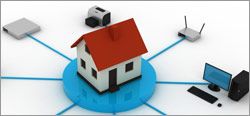How to Make Your Printer Wireless

As compact and sleek as some printers are, they can still take up a good chunk of your work area. That's a problem when your desk space is cluttered, or just limited. One way to clean up and maximize your workspace is to make your printer wireless, so that you can place it wherever there's room in your home or office.
Don't own a wireless printer? No problem. Here are three ways to turn any printer into a wireless one.
1. Plug into a wireless print server.
If your printer has a USB port, you can plug in a wireless print server, a small box into which you can connect your printer. The advantage of investing in a print server is that you don't have to connect the printer to a PC, which means you can use your laptop and print anywhere in your home.
We found plenty of print servers in the $50 range onNewegg.com, although many of the models cost closer to $75 or $100). Before you buy, make sure the print server is compatible with your printer (the printer's written materials are less likely to specify compatibility with print servers).
During the setup, you will have to plug the printer into the printer server, and connect that to the router using an Ethernet cable. Meanwhile, you'll have to install software on your computer and configure the connection, as you would when setting up a router.
2. Share your printer with other PCs in your home or office
If you have several computers sharing a printer (say, in a small office or your family's home) a cost-effective way to make the printer wireless is by connecting it to a host computer, going into the Control Panel in Windows, and enabling the printer to be shared on the network. Although this solution is free, the downside is that if the host computer is powered down, other computers on the network can't use the printer.
3. Buy a Bluetooth adapter
Almost every manufacturer sells an optional Bluetooth adapter, although they won't necessarily work with the model you're using. These units, which include a dongle for your notebook and a piece that attaches to the printer itself, usually cost about $40.
Stay in the know with Laptop Mag
Get our in-depth reviews, helpful tips, great deals, and the biggest news stories delivered to your inbox.
The benefit of connecting via Bluetooth is that if you have a simpler phone without Wi-Fi, you can still send files and pictures to the printer via Bluetooth (most laptops nowadays have Bluetooth as well). The trade-off is that older Bluetooth products, that use Version 1.1 or 1.2, have a rated range of 10 meters (about 33 feet), which is shorter than your router or Wi-Fi-enabled notebook's range. (Bluetooth 2.0 and 2.1, however, have a rated range of 100 meters.) The longer the range, of course, the more options you have when it comes time to find homes for your printer and laptop.
Dana Wollman was a contributing writer at Laptop Mag. Her coverage included reviews of some of the most iconic laptops from the previous decade, such as the Dell XPS, Dell Studio, HP EliteBook, and MSI Wind. She focused on smaller netbooks and productivity-oriented devices. After Laptop Mag, Dana worked as an Editor-in-Chief at Engadget, and is now a Senior Technology Editor at Bloomberg.
